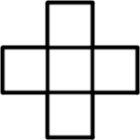Puzzles
24 December
There are 343 three-digit numbers whose digits are all 1, 2, 3, 4, 5, 6, or 7. What is the
mean of all these numbers?
Show answer
Hide answer
The digits 1 to 7 will each appear the same number of times as each other in each position of the number, so each digit of the mean will be the mean of the digits 1 to 7.
Therefore the mean is 444.
21 December
Noel wants to write a different non-zero digit in each of the five boxes below so that
the products of the digits of the three-digit numbers reading across and down are the same.
What is the smallest three-digit number that Noel could write in the boxes going across?
19 December
There are 9 integers below 100 whose digits are all non-zero and add up to 9:
9, 18, 27, 36, 45, 54, 63, 72, and 81.
How many positive integers are there whose digits are all non-zero and add up to 9?
Show answer & extension
Hide answer & extension
All the integers whose digits are all non-zero and add up to 9 can be made by taking a list of 9 ones, and between each pair deciding whether to move on a digit or not. For example,
1111|111|11 (where | means move on) would represent the number 432; and 1|1|1111111 would represent the number 117.
There are 8 gaps between 9s, so there are 28 = 256 numbers that can be made.
Extension
Why are there not 512 positive integers whose digits are all non-zero and add up to 10?
15 December
The number 2268 is equal to the product of a square number (whose last digit is not 0) and the same square number with its digits reversed:
36×63.
What is the smallest three-digit number that is equal to the product of a square number (whose last digit is not 0) and the same square number with its digits reversed?
Show answer
Hide answer
The only three-digit number that is equal to the product of a square number and the same square number with its digits reversed is 16×61 = 976.
14 December
153 is 3375. The last 3 digits of 153 are 375.
What are the last 3 digits of 151234567890?
Show answer
Hide answer
We can look at the first few powers and look for a pattern:
| n | 15n | Last 3 digits of 15n |
| 1 | 15 | 15 |
| 2 | 225 | 225 |
| 3 | 3375 | 375 |
| 4 | 50625 | 625 |
| 5 | 759375 | 375 |
| 6 | 11390625 | 625 |
| 7 | 170859375 | 375 |
| 8 | 2562890625 | 625 |
| 9 | 38443359375 | 375 |
If n is even (and > 2), the last two digits of 15n are 625.
12 December
Holly picks a three-digit number. She then makes a two-digit number by removing one of the digits.
The sum of her two numbers is 309. What was Holly's original three-digit number?
Show answer
Hide answer
Holly's sum is odd, so she must have removed the units digit and so her calculation was:
$$
\begin{array}{cccc}
a&b&c\\
&a&b&+\\
\hline
3&0&9
\end{array}
$$
\(a\) and \(b\) cannot both be 0, so the must sum in the tens column must've caused a carry into the hundreds column. This means that \(a\) must be 2, and the calculation is:
$$
\begin{array}{cccc}
2&b&c\\
&2&b&+\\
\hline
3&0&9
\end{array}
$$
Two single digits cannot add to 19, so there can't be a carry from the units column into the tens column. This means that \(b\) is 8:
$$
\begin{array}{cccc}
2&8&c\\
&2&8&+\\
\hline
3&0&9
\end{array}
$$
We can see now that \(c\) was 1, so Holly's three digt number was 281.
6 December
The number n has 55 digits. All of its digits are 9.
What is the sum of the digits of n3?
Show answer
Hide answer
We can look for a pattern as we increate the number of 9s that make up n:
| n | n3 |
| 9 | 729 |
| 99 | 970299 |
| 999 | 997002999 |
| 999 | 999700029999 |
| 9999 | 999970000299999 |
If n has k digits, then n3 is
k-1 9s,
followed by a 7,
followed by k-1 0s,
followed by a 2,
followed by k 9s,
The sum of all these digits will by 18k.
Hence, the answer is 18×55 = 990.
21 December
There are 6 two-digit numbers whose digits are all 1, 2, or 3 and whose second digit onwards
are all less than or equal to the previous digit:
How many 20-digit numbers are there whose digits are all 1, 2, or 3 and whose second digit onwards
are all less than or equal to the previous digit?
Show answer & extension
Hide answer & extension
We can look at how many \(n\)-digit number there are for small values of \(n\) and look for a pattern:
- 1-digit numbers: there are 3.
- 2-digit numbers: there are 6.
- 3-digit numbers: there are 10.
- 4-digit numbers: there are 15.
These are the triangle numbers, and there are 231 20-digit numbers.
Extension
Why is the pattern the triangle numbers?



